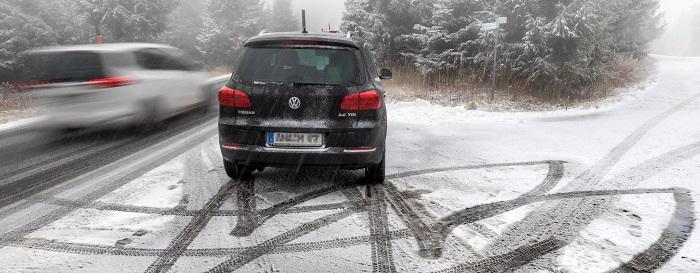
How to ride in the snow? Smoothly and without sharp maneuvers
 How to drive safely during icy conditions and heavy snowfall? The most important thing is to concentrate and anticipate the possible outcomes of all maneuvers.
How to drive safely during icy conditions and heavy snowfall? The most important thing is to concentrate and anticipate the possible outcomes of all maneuvers.
Winter is a tough time for drivers. Much depends not only on the skills, reflexes of the driver and the condition of the car, but also on weather conditions. At this time of the year, motorists should be prepared for sudden changes in conditions, adjusting their speed to them and exercising extreme caution.
Beware of black ice
One of the most dangerous phenomena that can occur in winter is sleet. It is rain or fog freezing on a chilled surface. A thin layer of ice then forms, uniformly covering the road, colloquially referred to by many drivers as black ice. Black ice most often occurs when cold and dry weather warms, which also brings precipitation. This is a very dangerous phenomenon, especially for user drivers. Black ice is sometimes referred to as black ice, especially when referring to dark asphalt pavement.
The dove is invisible, and therefore very treacherous and dangerous. When driving on an icy road, we usually see a snow-covered road with a normal surface at first glance. This phenomenon often occurs on viaducts and near rivers, lakes and ponds. Many drivers notice ice only when the car begins to skid.
However, it can be seen earlier. “If we get the impression that the car starts to flow along the road, does not respond to steering movements, and we do not hear the noise of rolling tires, then most likely we are driving on an icy road,” explains Michal Markula, rally driver and driving instructor. We must avoid sudden maneuvers in such situations. If other vehicles are at a safe distance from ours, you can also try stepping on the brake pedal. If, even after applying a little effort, you hear the noise of the ABS working, this means that the surface under the wheels has very limited traction.
The editors recommend:
Driver will not lose driver's license for speeding
Where do they sell “baptized fuel”? List of stations
Automatic transmissions - driver mistakes
Avoid skidding
When driving on an icy road, do not change direction abruptly. Steering wheel movements should be very smooth. The driver should also avoid sudden braking and accelerating. The machine still won't respond.
Many cars on Polish roads are equipped with ABS, which prevents the wheels from locking during hard braking. If our car does not have such a system, then in order to stop, to avoid skidding, one should brake with a pulsating one. That is, press the brake pedal until you feel the point at which the wheels begin to slip, and release it when skidding. All this in order not to block the wheels. In the case of cars with ABS, you should not experiment with impulse braking. When you need to slow down, press the brake pedal all the way down and let the electronics do their job - it will seek to optimally distribute the braking force to the wheels, and impulse braking tests will only increase the distance needed to stop.
If we have to change lanes or we are going to turn, remember that the steering movements must be smooth. Too much steering can cause the vehicle to skid. If the driver has doubts about whether he will cope with the icy road, it is better to leave the car in the parking lot and take a bus or tram.
See also: Skoda Octavia in our test